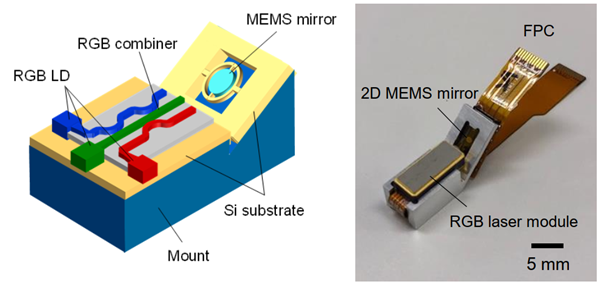Dec 11 2020
At the University of Fukui in Japan, researchers have realized considerable advances in creating a highly compact RGB laser projector with the ability to make a high-definition (HD) projection image.
 Diagram of the proposed device and the actual implementation, which is compact and thus suitable for wearable devices. Image Credit: University of Fukui.
Diagram of the proposed device and the actual implementation, which is compact and thus suitable for wearable devices. Image Credit: University of Fukui.
The device includes a waveguide-type coupler for generating exactly aligned RGB output beams from three independent lasers. It also has a microelectromechanical mirror for producing high-resolution scanning images. This technology can be further refined to gain a mail place in wearable displays like smart glasses.
The amazing advancement achieved in miniaturization in the past 10 years has made wearable electronic devices considered far-fetched in the 2000s achievable. Mail examples of such technology are smart glasses and similar head-mounted displays, which exploit recent progress in virtual and augmented reality to offer an immersive experience or hands-free utilities.
But prevalent prototypes of wearable displays smart and glasses pose some drawbacks that prevent their commercialization, for example, sub-par image quality, battery life issues and bulkiness.
At the University of Fukui, researchers have been achieving steady progress in developing an incredibly small yet robust image projector for eyewear displays. Together with SEIREN KST Corp., a Japanese silicon manufacturer, they have been gearing to commercialize their most recent innovations within a year.
As part of their latest study, presented at the 27th International Display Workshop (IDW ‘20), they successfully developed an optical engine by combining a compact RGB laser module that measures just 8 mm × 4 mm × 3 mm with a microelectromechanical (MEMS) mirror.
It is possible to electronically control the direction in which the MEMS mirror reflects light from the laser module, rendering it viable to project high-quality 2D images through laser scanning over the projected area.
One difficult aspect of developing the laser module was to integrate the light beams from three independent laser sources to obtain an RGB output. The researchers achieved this by using a waveguide-type combiner in which each of the three waveguides receives light from each of the primary colors.
Only the center green waveguide is linked to the actual optical output, but the red and blue light propagating on adjacent dead-end waveguides are passed to the center waveguide through couplers that are strategically positioned.
The measured efficiency of the combiner was as high as 97%, which represents a loss of only 0.13 dB. The outputs from the individual RGB lasers end up perfectly aligned thanks to the nature of the waveguide-type combiner.
Akira Nakao, Study Lead Author and Assistant Professor, University of Fukui
Furthermore, the use of an achromatic lens helps achieve an excellent circular focused beam, while offering the option to use other lenses to generate collimated beams with larger diameters.
By tuning the MEMS driving frequency, the laser beam scanning module can project 1280 × 720 color video. These properties, in combination with its small size and its potentially low battery consumption, render the proposed laser scanning projector a potential device for wearable displays.
Additional tuning will be needed to make it viable to safely project images directly onto the retina of the human eyes. However, the team has been working on this aspect and the foundations have been laid for this new technology.
At the University of Fukui, we are trying to stir things up in the wearable display industry by developing smart glasses with optical engine, driver circuit, projector, and battery all integrated in one single device.
Akira Nakao, Study Lead Author and Assistant Professor, University of Fukui
The applications of wearable displays also extend beyond those of virtual and augmented reality for entertainment and could enable better surveillance, conferencing and even remote-assisted surgery.
“For now, our unit can be used in laser microscopes, sensors, projectors, and HUD displays, particularly those for novel automobile systems with intelligent driving technology, which are all set to reshape our future,” stated Asst. Prof. Nakao, explaining more about the possible applications.